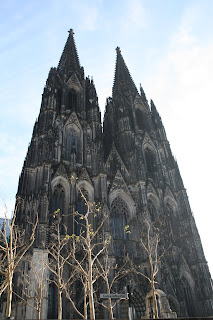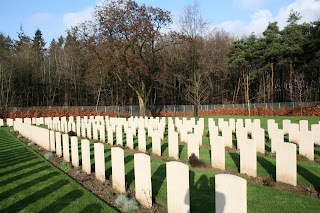 I'm back in my mouse-hole of a hotel room, reflecting on the day and googling a good German restaurant (aka has good beer) for dinner.
I'm back in my mouse-hole of a hotel room, reflecting on the day and googling a good German restaurant (aka has good beer) for dinner.There are 2 important things to note here:
One) I made it home safely from today's adventure, which included renting a car in Germany and driving on the Autobahn. Thank goodness I know how to drive standard!! While it may only be a suggestion, there is a posted speed limit of 130km on the Autobahn. Driving in the city was MUCH more intimidating. Apparently, you just know the streets and where to go. They don't believe in signs, and even if they do, I can't understand them.
Two) I am ready to go home and want to enjoy one more German beer before I go, maybe even a bratwurst if I'm so brave.
Before I get to today's tale, here  are some pictures from the Cathedral from yesterday. While I'm at it, let's have a little history lesson. This Roman Catholic Cathedral, or Dom in German, dedicated to the Virgin Mary and St. Peter is the largest in Northern Germany, a UNESCO World Heritage Site and probably also one of the busiest. I knew it was going to be relatively easy to find when I arrived in Cologne, but what I wasn't expecting was to walk out of the train station and stand directly beside it. It's stunning and it's massive size took my breath away. Started in the 1200's, the DOM was not completed until 1880. It survived the war, relatively unscathed as much of Cologne was flattened. According to stories I read, the Allies may even have used it as a navigational landmark as the city sits next to the Rhine river on the far west side of Germany.
are some pictures from the Cathedral from yesterday. While I'm at it, let's have a little history lesson. This Roman Catholic Cathedral, or Dom in German, dedicated to the Virgin Mary and St. Peter is the largest in Northern Germany, a UNESCO World Heritage Site and probably also one of the busiest. I knew it was going to be relatively easy to find when I arrived in Cologne, but what I wasn't expecting was to walk out of the train station and stand directly beside it. It's stunning and it's massive size took my breath away. Started in the 1200's, the DOM was not completed until 1880. It survived the war, relatively unscathed as much of Cologne was flattened. According to stories I read, the Allies may even have used it as a navigational landmark as the city sits next to the Rhine river on the far west side of Germany.
 are some pictures from the Cathedral from yesterday. While I'm at it, let's have a little history lesson. This Roman Catholic Cathedral, or Dom in German, dedicated to the Virgin Mary and St. Peter is the largest in Northern Germany, a UNESCO World Heritage Site and probably also one of the busiest. I knew it was going to be relatively easy to find when I arrived in Cologne, but what I wasn't expecting was to walk out of the train station and stand directly beside it. It's stunning and it's massive size took my breath away. Started in the 1200's, the DOM was not completed until 1880. It survived the war, relatively unscathed as much of Cologne was flattened. According to stories I read, the Allies may even have used it as a navigational landmark as the city sits next to the Rhine river on the far west side of Germany.
are some pictures from the Cathedral from yesterday. While I'm at it, let's have a little history lesson. This Roman Catholic Cathedral, or Dom in German, dedicated to the Virgin Mary and St. Peter is the largest in Northern Germany, a UNESCO World Heritage Site and probably also one of the busiest. I knew it was going to be relatively easy to find when I arrived in Cologne, but what I wasn't expecting was to walk out of the train station and stand directly beside it. It's stunning and it's massive size took my breath away. Started in the 1200's, the DOM was not completed until 1880. It survived the war, relatively unscathed as much of Cologne was flattened. According to stories I read, the Allies may even have used it as a navigational landmark as the city sits next to the Rhine river on the far west side of Germany.It could be assumed, my great uncle Norman, my Grandma's  brother, may also have navigated over Germany via this Cathedral. Unfortunately, like thousands of other airmen, his plane did not come back and today, he rests in Rheinberg War Cemetary.
brother, may also have navigated over Germany via this Cathedral. Unfortunately, like thousands of other airmen, his plane did not come back and today, he rests in Rheinberg War Cemetary.
 brother, may also have navigated over Germany via this Cathedral. Unfortunately, like thousands of other airmen, his plane did not come back and today, he rests in Rheinberg War Cemetary.
brother, may also have navigated over Germany via this Cathedral. Unfortunately, like thousands of other airmen, his plane did not come back and today, he rests in Rheinberg War Cemetary. I have noticed that most German's do not openly provide details about the war. On our Cathedral tour in Speyer, I asked how the Cathedral faired and during the Heidelberg tour, the guide shared Germany's history, concluding with "we all know what happened from there" when she reached the appointment of Hitler to Chancellor. I don't know what that means, and maybe it means nothing. After all, we do all know the country's history since the 1930's.
 Visiting the cemetary was a little surreal. It was a miserable day, pouring rain on the drive from Cologne to Rheinberg, but the rain cleared as I found the cemetary. I have to admit, I did have some trouble, and I drove around for at least 15-20 minutes trying to find it. I later noticed a sign in town I had missed, but it still would not have led me there any faster. For anyone that chooses to visit Rheinberg War Cemetary, turn left when you come off the Autobahn, this will take you towards Kamp Linfort and right past the cemetary.
Visiting the cemetary was a little surreal. It was a miserable day, pouring rain on the drive from Cologne to Rheinberg, but the rain cleared as I found the cemetary. I have to admit, I did have some trouble, and I drove around for at least 15-20 minutes trying to find it. I later noticed a sign in town I had missed, but it still would not have led me there any faster. For anyone that chooses to visit Rheinberg War Cemetary, turn left when you come off the Autobahn, this will take you towards Kamp Linfort and right past the cemetary.The majority of the men were airman.
 Norman's plane went down on September 23, 1943, and walking through the stones, it appears that many others went down that day as well. It was heartbreaking to see how young they were, mostly in their early 20's. Including Norman, who was only 22. There were also several unidentified men in the cemetary, marked only by a stone reading "An airman or the 1939-1945 war" or "A soldier".
Norman's plane went down on September 23, 1943, and walking through the stones, it appears that many others went down that day as well. It was heartbreaking to see how young they were, mostly in their early 20's. Including Norman, who was only 22. There were also several unidentified men in the cemetary, marked only by a stone reading "An airman or the 1939-1945 war" or "A soldier".All waves of emotion came over me within the cemetary. The clouds did break for a while, and the sun even came out as I walked between the rows. A crow watched overhead, and I couldn't help but recite the verses of Flanders Fields in my head and aloud. With the sound of
 the odd airplane overhead, I found myself thinking about what it would be like to wonder if that plane would be the one that dropped a bomb on your town, family's or neighbour's home. All week, I have imagined the countryside as it must have looked then. The rolling fields and scattered forests between towns, battered and scarred with years of war. Brick fencerows in shambles with cords of barb wire tangled along the top. I have looked at old brick buildings and wondered how many houses were destroyed and the bricks salvaged to rebuild after the bombs stopped.
the odd airplane overhead, I found myself thinking about what it would be like to wonder if that plane would be the one that dropped a bomb on your town, family's or neighbour's home. All week, I have imagined the countryside as it must have looked then. The rolling fields and scattered forests between towns, battered and scarred with years of war. Brick fencerows in shambles with cords of barb wire tangled along the top. I have looked at old brick buildings and wondered how many houses were destroyed and the bricks salvaged to rebuild after the bombs stopped.Of course, many of these images are due to Hollywood's imagination, rather than my own, however I think it's important to try to understand, although I never will be able to fully comprehend.
So, I am now ready to go home. My legs are sore from walking everywhere (who knew it was such hard work) and I am tired of breathing in cigarette smoke. A lot of people smoke here, including inside from time to time. I'm not sure how I'll fit everything in one suitcase, so that may be a task for this evening. Otherwise, I'm going to enjoy some beer, and maybe one more gluhwein (pronounced glue-vine).



No comments:
Post a Comment